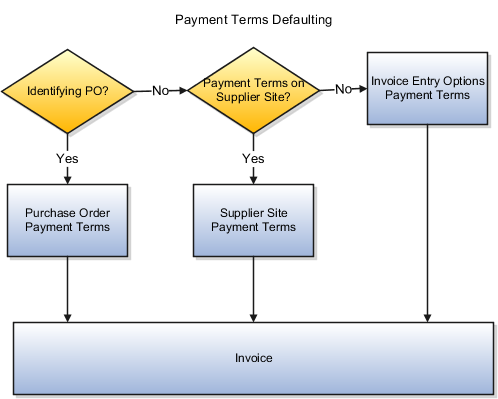Payment Terms
Payment terms are used to automatically create invoice installments. You can define payment terms to create multiple installments and multiple levels of discounts.
Payment terms consist of one or more lines, each of which creates one invoice installment. When you define a payment term, you can specify either percentages or fixed amounts. A payment term line can have up to three discounts. Each line and corresponding installment have a due date and up to three discount dates. Each line and corresponding installment also have due or discount amounts. You can assign a payment term to one or more sets to share that payment term across business units.

Payment Terms Due Dates and Discount Dates
Payment terms due dates and discount dates are based on one of the following methods:
-
Fixed Date: A specific day, month, and year that an installment is due for payment.
-
Days: A number of days added to the invoice terms date.
-
Calendar: A Payables calendar that's divided into periods. You can assign a due date to the period that includes the invoice terms date. You can assign due dates to avoid weekends, holidays, and so on. You can't assign calendar-based terms to an invoice if a period isn't defined for the terms date.
-
Day of Month: A type of payment term with the following attributes:
-
Day of Month: A specific day of the month when an installment is due for payment. For example, enter 15 to schedule payment on the fifteenth day of the month. Enter 31 to schedule payment for the last day of the month, including months with less than 31 days.
-
Cutoff Day: The day of the month after which the installment due and discount dates advance to a future month. If you don't specify a cutoff day, the current accounting month is used to determine due and discount dates.
-
Months Ahead: The number that's used to determine the month the installment is due. If you enter 0 and the terms date is the same as, or later than, the cutoff day, the installment is due the following month.
For example, a payment term has a Cutoff Day of 11, the Day of Month is 15, and Months Ahead is 0. If you enter an invoice with a terms date of January 12, the installment is due February 15. If you enter an invoice with a terms date of January 10, the installment is due January 15. If the terms date is January 12 and Months Ahead is set to 1, the installment is due March 15.
-
Default Payment Terms
If you enter an Identifying PO on an invoice, the purchase order provides the default payment terms for the invoice. If you don't enter an Identifying PO, the supplier site provides the default payment terms. If the supplier site doesn't have payment terms, the payment terms from the Manage Invoice Options page are used. You can override the default payment terms on any invoice.
